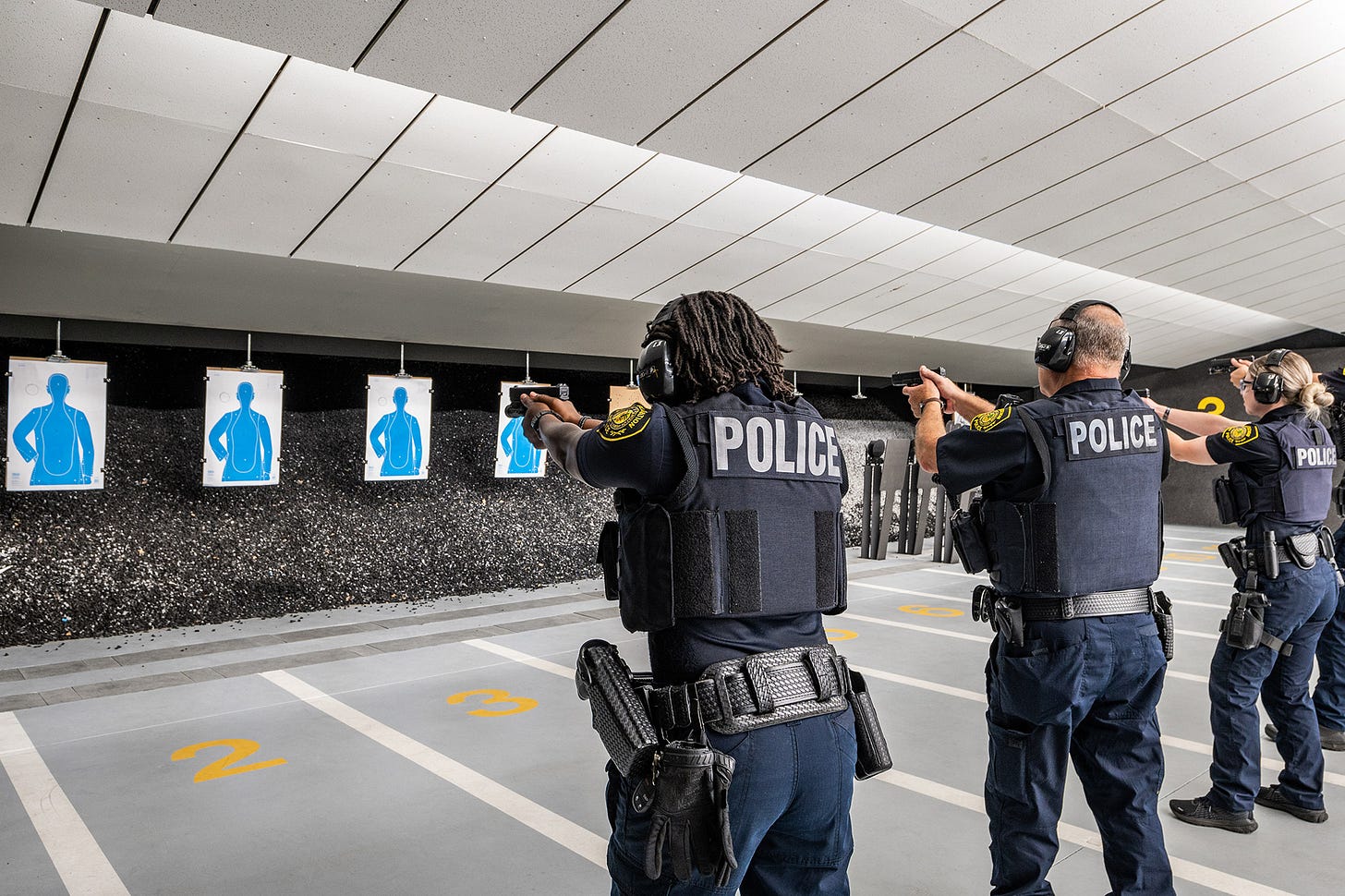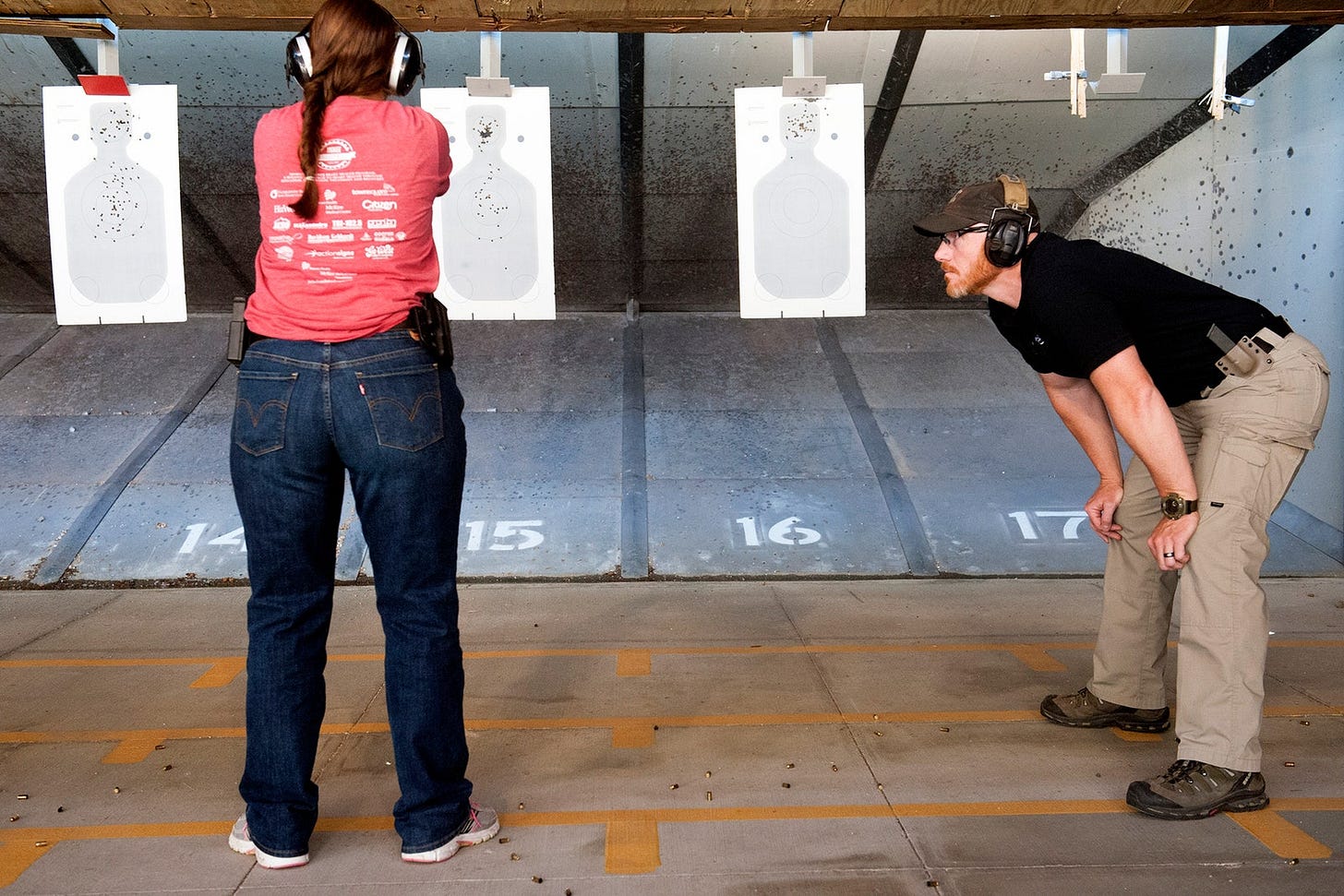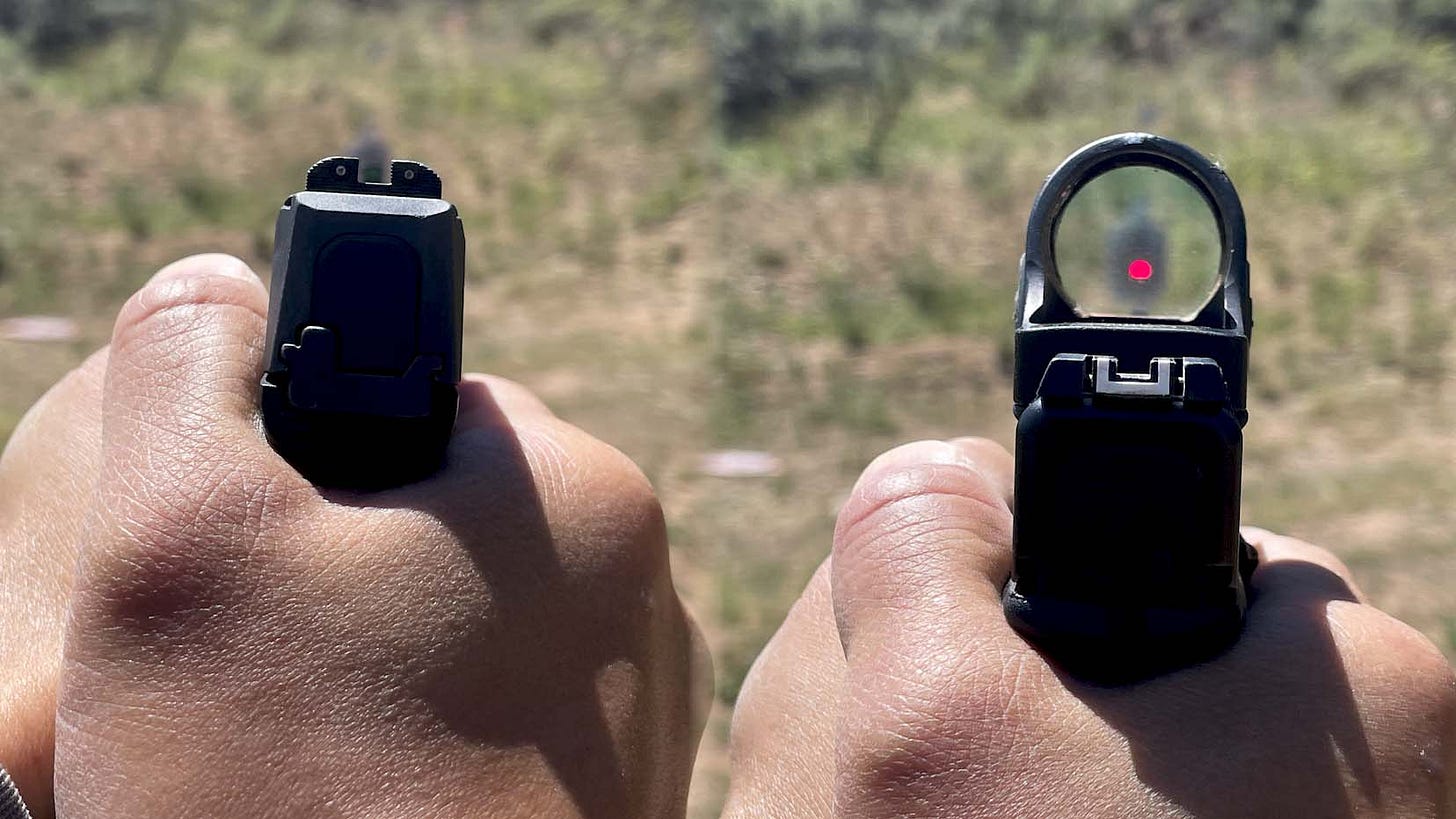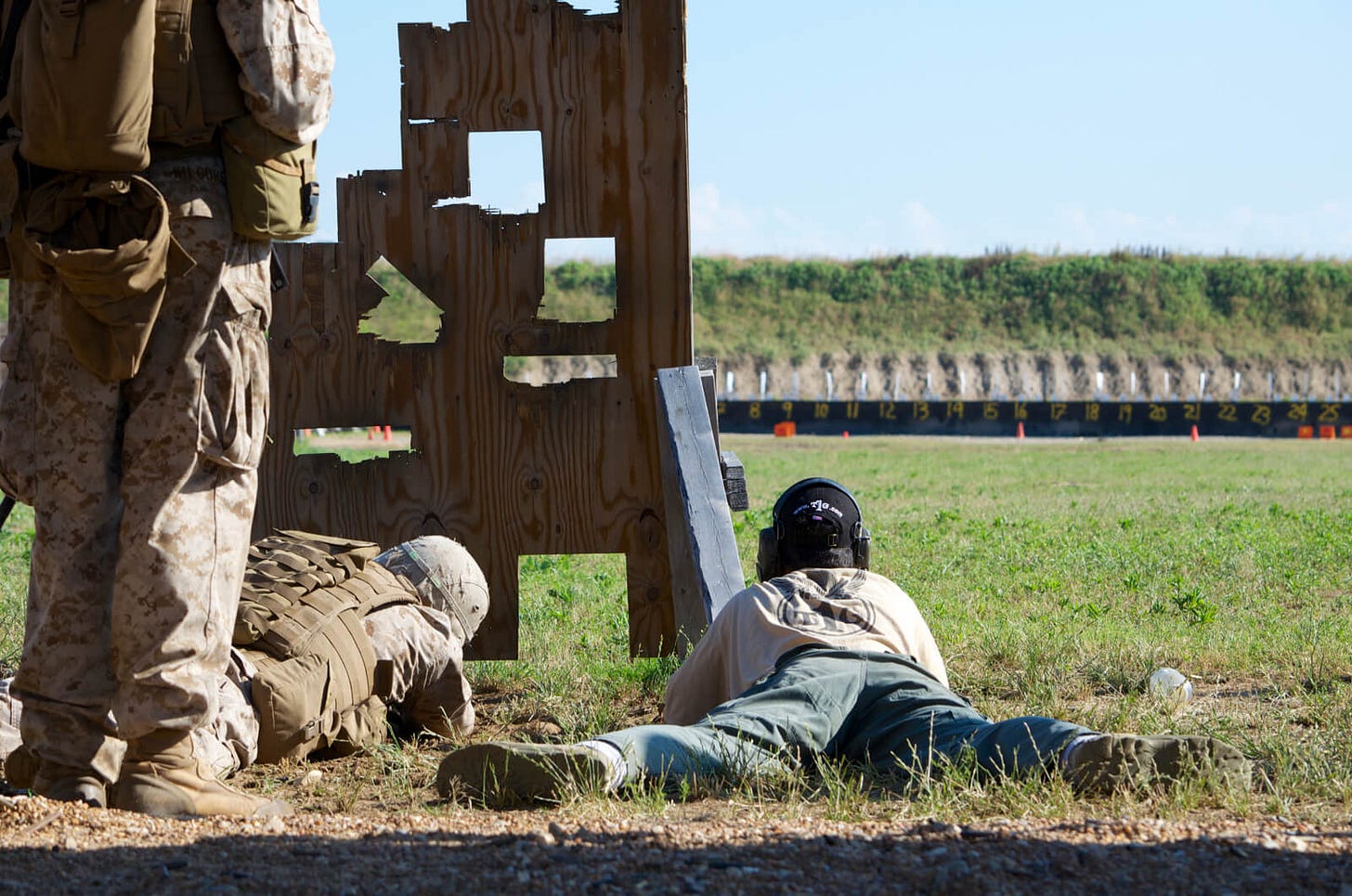Police responding to school shootings can learn from the US Marine Corps
The world's most lethal fighting force realized that marksmanship training was outdated and was not preparing Marines for real-world combat conditions.
Since World War II, US Marines had been taught to shoot by lining up on a range and firing at human sized targets with iron sights (traditional rifle sight before optics/scopes became standard).
This is the same way that most police departments train officers to shoot. The officers line up at a shooting range, stand still, look down the sights on their handguns, and fire at stationary human-shaped targets in front of them.
The most basic concept of marksmanship is lining the sight up with your target and firing before the gun or the target moves. But everything changes when the shooter and/or the target(s) start moving. The real world for Marines is shooting rifles with optics at all different distances while moving between streets, alleys, and inside of buildings. Shooting accurately becomes exponentially more difficult with obstructions, distractions, and multiple moving elements between a moving shooter and a moving target.
The USMC recently realized that their marksmanship training was outdated because their training weapons didn’t match their battlefield weapons, and the training shooting positions didn’t match real world combat situations. An article in the September 2024 Marine Corps Gazette explains how training is being dramatically shifted to fix these problems (Continuously Revolutionizing Small-Arms Lethality).
Instead of scoring shooting qualification tests by counting hits on a simple fixed target, the USMC is moving to dynamic scoring system based on multiple factors including speed, accuracy, and lethality (see more below including a link to a podcast about it).
Impact for schools and police
If US Marine Corps training and qualification test was not meeting the requirements to teach soldiers the skills needed for a dynamic battlefield, does training for police, armed school security, and armed teachers/staff match the real-world environment during a school shooting? The answer is no.
Just like the WWII Marines on the range, the picture below is a teacher taking a training class before carrying a gun inside a school. She stands at a line and fires a short distance at stationary, human-shaped targets inside a well-lit, calm setting with no distractions, movement, or bystander/friendly targets in the area.
A teacher, administrator, security officer, and even a school police officer can be “qualified” (e.g., meet the state or local training standard) to carry a gun inside a school simply by hitting a paper target at a range. While many police departments and school districts conduct dynamic active shooter training, individual performance during these sessions is not quantified and used as a pass/fail for qualification to carry a firearm.
Just like the Marines, what are the skills that school police officers and armed teachers need to learn, constantly practice, and be proficient in? Instead of a stationary paper target, scored firearms qualification tests for someone carrying a gun inside a school should replicate real-world environments.
Shooting while moving: Firing a gun while standing still, sitting, or laying down is nothing like shooting a gun while moving. The balance, support, posture, and breathing needed to shoot accurately all change when you are walking or running.
Shooting at moving target: When a surprise attack by a student starts inside a school, the student with a gun isn’t going to stand still at exactly 15 yards for 45 seconds. Unlike shooting at a stationary target, shooting at a moving target requires anticipating where the target is going while visually scanning the entire area to make sure that bystanders aren’t in the path of the bullet (both in front of and behind the assailant).
Running/sprinting before shooting: Many school campuses have +100 yards of distance between the parking lot and classrooms in the center of the school building. At a 2 million square foot campus like Apalachee High in Georgia, there can be a half mile between a police officer on campus and the assailant. Running 100 yards or more completely changes your breathing patterns and fine motor skills. During an active shooter response, a patrol office may have regular duty gear plus a rifle, go bag with EMS supplies and extra ammo, tactical vest with a ceramic plate, forceable entry tools, shield, and helmet. How many officers have practiced running 500 yards with a hundred pounds of gear before shooting accurately?
Shooting with an optic versus iron sight: Most police training and courses for armed teachers use a pistol with a conventional fixed sight. In the real world, there are many different optics available that can magnify the target or create a floating dot over the target. To use these optics effectively, they need to be calibrated and the user needs to know the correct position to hold the gun while firing. Optics allow for a much higher degree of accuracy (which is why the USMC uses them in battle—and now in training) so training for police and armed staff should also account for this equipment.
Shooting in the dark: The standard procedure for a lockdown in a school is to turn off the lights and close the blinds in every classroom. If an officer drives a police car to the school in the middle of the day, their eyes will need to rapidly transition from bright sunlight to darkness. Adrenaline naturally released during intense stress causes blurry vision which means that officers are hampered by two different factors that reduce vision inside a dark classroom.
Shooting in smoke: In the DOJ report on Uvalde, officers reported that gun smoke from hundreds of rounds being fired combined with dust from bullets breaking apart concrete blocks and ceiling tiles made it difficult to see and breathe in the school hallway. Shooting targets in a clear and well-lit shooting range is different from shooting a target obstructed by smoke while your eyes are tearing.
Shooting with loud noise: An AR-15 or shotgun fired inside a hallway with concrete walls and tile floors is literally deafening. The sound is so intense that it can cause flashing in your eyes, immediate headache, and ears ringing. Firing an accurate shot while dealing with this physical pain and disorientation is very difficult.
Shooting while taking fire: Beyond the noise from bullets being fired, if there is an assailant shooting back at an armed teacher or school police officer, they immediately need to find and then return fire from cover. This is a completely different skill than standing on the line at a shooting range. Officers can’t blindly lay down suppressing fire inside a school because they might hit bystander students and teachers (this was a problem during the Pulse Nightclub response).
Shooting with multiple moving bystanders/friendly targets: Firing at a single stationary target doesn’t replicate the real-world situation that a school will be full of students, staff, and other responders who are moving across the field of fire. An effective training scenario needs to have movement of both the target and multiple “no shoot” friendly targets. Instead of focusing on just one fixed target, police and armed school staff need to learn how to see the entire environment and not fire when there is a risk of shooting a bystander or another police officer (this was a problem at the STEM School in Highland Ranch, CO when an armed security guard shot at plainclothes police officers and struck bystanders students).
Shooting armored target: The standard shooting qualification target for police, armed school security, and armed teachers focuses on hitting “center mass” which is the biggest target. Unfortunately, ballistic body armor can be purchased online and the Parkland school shooter is pictured here wearing it. If training focuses on “center mass”, shots are being fired into the most substantial part of a bulletproof vest.
Shooting child-sized target: The sad reality of school shootings is that most are committed by current students at the school. In Richneck, VA, a 6-year-old boy intended to kill his teacher. If she was trained to be armed in the classroom, practicing with a target the size of an adult would not replicate the conditions of shooting a child. This sounds awful but the harsh reality we need to remember is that if there are school staff with guns, they are being armed to shoot children.
Shooting at long distance or unknown distance: Before the gunman entered Robb Elementary in Uvalde, an officer with a rifle had the assailant in his sights. The problem is the shot was 148 yards and the officer didn’t feel confident taking it. The tiny targets you can barely see in the photo below are 150 yards (1.5 football fields) away. Shooting accurately and confidently at this distance takes constant practice. On a large school campus with multiple athletic fields and large parking lots, there are countless scenarios where an officer with a rifle could need to fire +100 yards at an assailant.
Shooting at elevated target: At the Edmund Burke School in Washington, DC, a gunman fired 239 shots from a 5th story apartment across from the school. Police (or anyone) rarely practices shooting at an elevated target because if the shots miss, the bullet can travel for more than a mile. It’s hard to find a shooting range that has a safety area cordoned off for more than a mile around the range. Just because this is dangerous training doesn’t mean that police departments don’t need to be ready for a scenario with an elevated sniper targeting a school. If there are any tall buildings with a clear line of sight to a school campus, this can happen.
Coordinated movement of multiple officers while shooting: When a group officers or armed school staff are moving together into a classroom or hallway as they try to engage a perpetrator, it is easy to accidentally cross in front of a gun. For example, when officers entered a classroom at CVPA High in St. Louis and started firing at the teenage school shooter, an officer ended up directly in front of another officer who was shooting. In this near miss, bullets were fired on either side of his head (pictured below). To move and shoot safely as a group (known as squad-based tactics in the USMC), everyone needs the same training to know which way each person will turn and what parts of a room they will be pointing their gun at.
Keep reading with a 7-day free trial
Subscribe to School Shooting Data Analysis and Reports to keep reading this post and get 7 days of free access to the full post archives.














